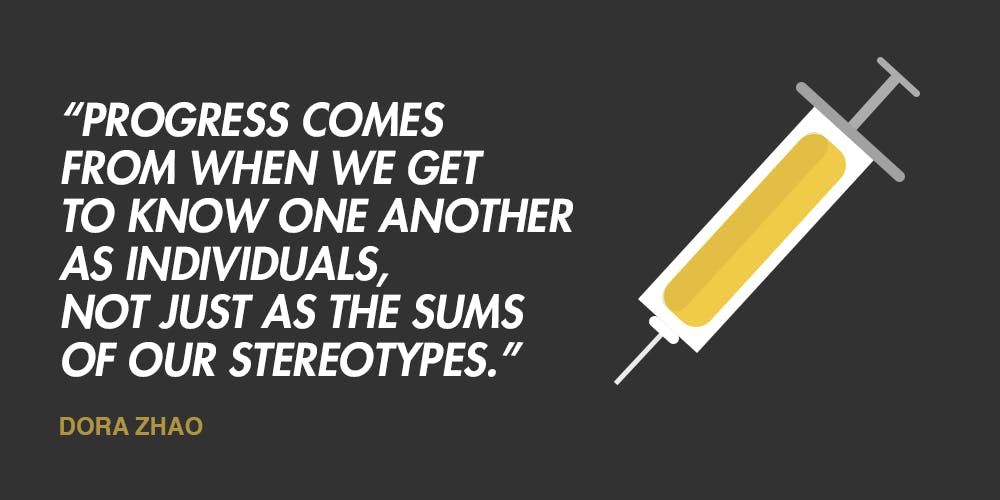I had my first encounter with “yellow fever” my sophomore year of high school. As I watched my friend pine after a different girl every month, I could not help but notice the common denominator — they were all Asian. While I wanted to give him the benefit of the doubt, it reached the uncomfortable point where his choices blurred from having a “type” to having a fetish. Yet, I decided not to intervene — a choice that I have come to greatly regret.
There has already been discourse about “yellow fever” across college campuses. Most recently, a columnist for the Yale Daily News wrote an insightful article on the harmful effects of racial fetishism. While bringing awareness is important, these articles have focused solely on “yellow fever” through the lens of the white male-Asian female relationship. These relationships do occur more often. But by quarantining the problem, we are glossing over the fact that people of color can engage in racial fetishism. In any form that it comes, regardless of the perpetrator, we cannot reduce anyone to a mere token.
Not to be mistaken with the mosquito-transmitted virus, “yellow fever” refers to a pejorative cultural term describing men who have an obsession, typically in the form of a sexual fetish, for Asian women. While it is important to note that not every man dating an Asian woman has “yellow fever,” it becomes an issue when there is not only a clear pattern but also a history of problematic behavior within the relationship.
Objectifying Asian women is not exclusively limited to white men. Most saliently, if we analyze rap music, Asian women frequently become sexual tokens. For example, the rapper Donald Glover, also known as Childish Gambino, makes frequent mention of his fetish for Asian women. In his song “You See Me,” Glover gleefully exclaims that he is “ballin’ each and every day / Asian girls everywhere, UCLA” and that he “need some variation / especially if she very Asian.” It is not an isolated example. He also promotes the negative stereotype of the emasculated Asian male which is often juxtaposed to the hypersexualized Asian female archetype. When talking about using Asian female bodies as sexual objects, the lyrical phrase “eatin’ Asian p***y, all I need was sweet and sour sauce” from Kanye West’s “I’m In It” is a particularly explicit example as well.
Of course, this form of fetishism is different from the traditional power dynamic that we see. When we look at white men turning Asian women into sexual objects, it comes with strings attached. It comes with the history of laws like the Page Act of 1875, which barred most Asian women from immigrating to the United States, casting them all as prostitutes and the U.S. occupation of Asian countries during the late twentieth century. It comes with the Suzie Wongs, the Madame Butterflies — the reduction of Asian women to oversexualized erotic tropes.
The sexual fetishism by non-white men is no less harmful. Even though it may not come bearing the same weight of institutionalized subjugation, it still paints Asian women as two-dimensional characters. Instead of being respected for their personalities and individual beings, they become just more bodies molded to fit prescribed stereotypes.
This discussion is not limited to just intimate relationships. Rather, it is reflective of a larger issue — horizontal prejudice. Sometimes also termed “lateral violence,” horizontal prejudice describes negative actions against one’s peers rather than one’s adversaries. In this context, it means targeted groups acting in a racist manner toward members of their own race or of a different minority group.
Horizontal prejudice is not something we can ignore. Just because you aren’t white does not inoculate you from perpetuating systems of oppression. The sexual fetishization of Asian women by men of color is only one instance. It is a two-way street, and we are all admittedly complicit. Anti-blackness in the Asian community, colorism, Chris Rock’s joke at the 2016 Oscars — all examples of horizontal prejudice.
It is hard, almost impossible, to undo centuries of internalized oppression. People of color have been historically pitted against each other, driving deep-seeded wedges between their communities. But there is still possibility for change. The first and most important step to getting there is creating more opportunities for cross-cultural dialogue. Whether that is in classrooms, in the workplace, or on the streets, we need to understand that there is no “other” in the equation.
Even after learning jargon-y terms like “horizontal prejudice,” we cannot weaponize our knowledge. The world does not divide neatly into the guilty and the innocent, the prejudiced and the fair. Instead, we are all complicit in oppressive practices. But rather than wallowing in the existing problems, we must recognize our own shortcomings and learn how to move toward a more equitable society.
While we cannot erase the color line, engaging with each other will help us understand that there are similarities in our experiences. Solidarity matters. And even if we did not face these struggles, we must come to learn empathy and to not discount someone else’s experience. Progress comes from when we get to know one another as individuals, not just as the sums of our stereotypes.
Dora Zhao is a first-year student from Newtown, Pa. She can be reached at dorothyzhao@princeton.edu.









